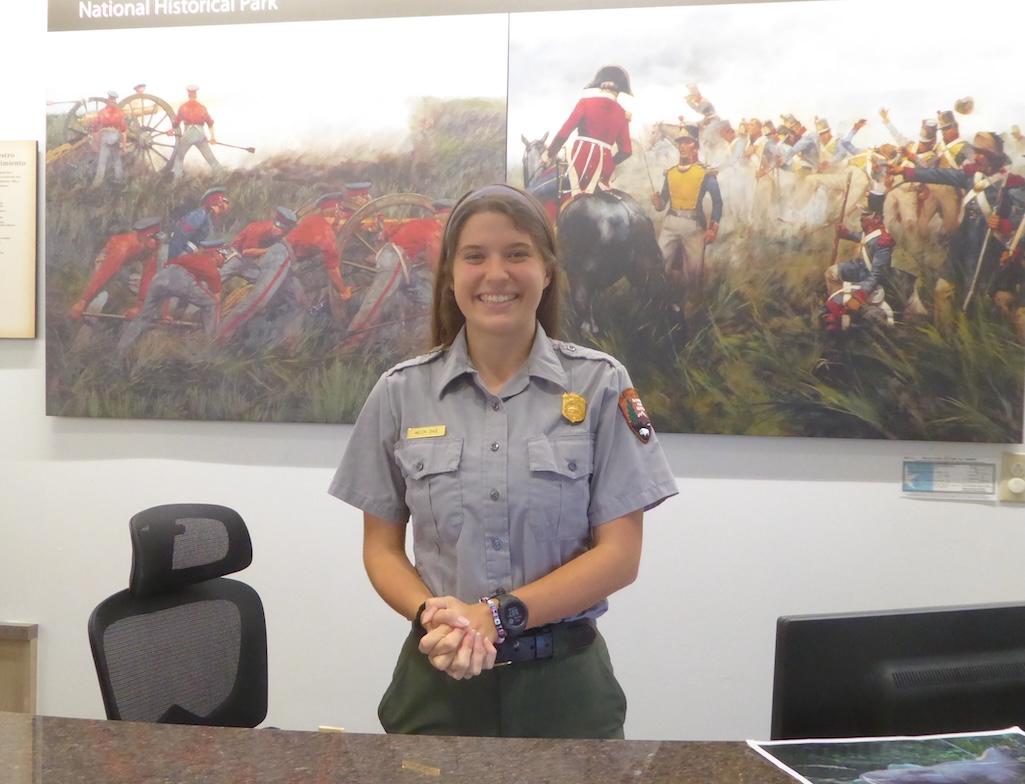
Helen Dhue, a ranger who worked at Lassen Volcanic National Park, Gulf Islands National Seashore, and Palo Alto Battlefield National Historical Park lost her job on Valentine's Day/David and Kay Scott
During a late December road trip through Texas along the Gulf Coast and Rio Grande River we stopped a few miles north of Brownsville to visit Palo Alto Battlefield National Historical Park. We had visited the site a couple of decades ago but at the time found little other than a sign identifying the park location. The national historical park is now up and running with a visitor center, picnic area, cannons, flags, and improved walking trails with informative signage offering visitors information about one of America’s significant, but little-known military battles.
In the visitor center we were welcomed by a smiling park guide, Helen Dhue. Dhue had arrived at the park in August following a year-long paid internship at Lassen Volcanic National Park in California. Prior to her experience in Lassen, she had worked in the Mississippi unit of Gulf Islands National Seashore. Mentioning our earlier visit and the site’s subsequent development, Ranger Dhue replied with a smile, “We tell visitors this is a small park that tells a big story.”
Palo Alto Battlefield NHP is the only unit of the National Park Service that focuses primarily on the Mexican-American War. Neither of us could recall spending much time studying the conflict in school even though it resulted in the United States gaining control of approximately half of Mexico’s territory.
Not surprisingly, the initial battle was in Texas, an area that had been colonized by the Spanish in the 1700s and annexed by the United States in 1846, ten years following the Republic of Texas declaring independence from Mexico. The annexation did not sit well with Mexican authorities, who claimed ownership of the land and considered its international border to be north of the Rio Grande, along the Nueces River.
U.S. President James Polk chose to demonstrate U.S. authority by constructing a star-shaped earthen fort referred to as“Fort Texas”along the Rio Grande River. This, in turn, precipitated an unsuccessful Mexican siege on the fort that turned into a battle with U.S. reinforcements at nearby Palo Alto, a broad prairie where the initial battle of the Mexican-American War took place. The ensuing 5-hour battle was won decisively by U.S. forces who utilized superior cannons that shot explosive shells rather than solid balls used in Mexican cannons.
Retreating Mexican soldiers reassembled in a thicket several miles south at Resaca de la Palma for another stand that proved futile due to the American firepower. These were the first two battles of a war that would conclude two years later when U.S. forces gained control of Mexico City in September 1847.
In addition to an introductory film and exhibits, the park visitor center has books for sale and provides visitors with a brochure that includes an overview of the conflict plus a map of the park. A free trail guide is available for those who wish to explore the battlefield along a half-mile trail leading to a battlefield overlook. A connecting trail of several hundred yards along Mexican Line is bordered with Mexican flags and interpretive signs. Auxiliary parking is available for those who wish to gain access to the battlefield overlook without walking the half-mile trail from the visitor center.
We particularly enjoy visiting smaller and less-crowded national park units such as Palo Alto where both visitors and Park Service personnel seem more at ease. The park probably welcomed no more than two or three dozen people during our two-hour visit in late-December, which is prime time for tourist season in southern Texas.
Palo Alto Battlefield National Historical Park is located in Brownsville, Texas, on FM 1847 (7200 Paredes Line Road) just north of the intersection with FM 511. The visitor center is open Tuesday through Saturday from 9 a.m. to 4 p.m. Times change seasonally and individuals planning a visit should check current operations by calling (956) 541-2785, ext. 333.
The less-developed site of the second battle at Resaca de la Palma is a little less than 6 miles south of Palo Alto Battlefield via Paredes Line Road. This site has a restroom and a walking trail with signage, but does not have a visitor center. Neither site charges an entrance fee. Little evidence remains of Fort Texas, later renamed Fort Brown in honor of Jacob Brown, commander of the fort who died from injuries suffered during the Mexican siege.
Postscript: Following our visit to Palo Alto Battlefield National Historical Park we learned Ranger Dhue was among the 1,000 National Park Service employees included in the recent federal cutbacks. Ms Dhue learned of her termination while returning from a work trip to southern Arizona. The impersonal termination letter stated, “The department determined that you have failed to demonstrate fitness or qualifications for continued employment because your subject knowledge, skills and abilities do not meet the department’s current needs.” Based on our experience in talking with Dhue in the Palo Alto visitor center she was friendly, knowledgeable, and excited about the opportunity to work with the National Park Service. Her firing was a disservice to Dhue, the National Park Service, and all of us who care about the national parks.

 Support Essential Coverage of Essential Places
Support Essential Coverage of Essential Places






